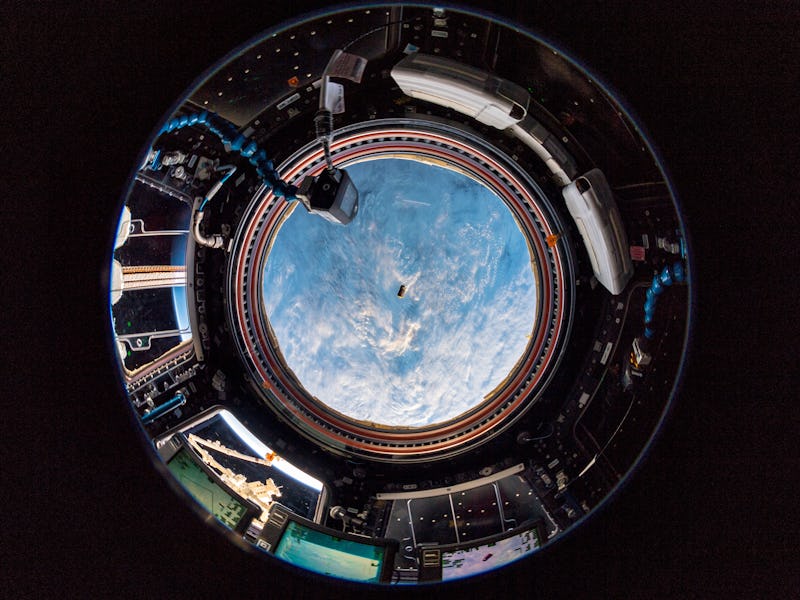High School Senior's Genius Plan to Grow Space Broccoli Made It to the ISS
"There was a lot of just speechless gaping."

Most teens try to leave a part of their high school lives behind when they start college, but Sarina Kopf’s secret was too cool to keep hidden. When she started as a freshman at Iowa’s Grinnell College this year, she didn’t tell anyone that a few months prior, she’d been hand-selected by NASA to send a brilliant space farming project to the International Space Station. Her project reached its final destination when SpaceX’s Dragon capsule docked with the ISS in early December.
As a high school student in Colorado’s Lakewood High School, Kopf had spent years devising an ingenious gardening system that would make it easier for astronauts to grow food in space. All her work paid off: Her project was one of two winners of the Marvel Guardians of the Galaxy Space Station Challenge, which tasked high school students around the country to design experiments to investigate pressing questions about life in microgravity. The prize was a coveted spot on the ISS that the project could call its own.
“Actually most of my professors don’t know. It just never came up,” Kopf tells Inverse. “I’ve been keeping this project kind of on the down low.”
Her experiments are now underway alongside the astronauts they might someday feed, but Kopf prefers to keep a low profile. She watched her project go up on SpaceX’s rocket from the Bonanza Creek launch viewing site near Cape Canaveral with her family and project teammates, saying “It was thrilling, exciting, and humbling. There was a lot of just speechless gaping.
But a project like hers couldn’t be kept secret for long. Shortly after Kopf watched her project go up, the pole vaulter ran into the captain of the track and field team.
“When I got back my captain walked up to me and was like, ‘Hey! That’s so cool! Tell me about the thing! Is it really true that you have something going to space?’”
Kopf (center), with her teammates.
Plants in Space
The problem Kopf had tried to tackle throughout her junior and senior year of high school was a deceptively simple one: How can you effectively grow plants in space?
On Earth, the most effective way to grow plants is to use an aeroponic system, which reduces water usage by up to 98 percent, according to NASA. A spin-off of a hydroponic system, which floods the roots of a plant with water and nutrients, aeroponic systems coat root systems with a nutrient-laden mist to maximize water absorption without overburdening the plant.
NASA has been experimenting with hydroponic and aeroponic farming since the late 90s to figure out how to maximize food growth for long-term missions. If all goes according to plan, Kopf’s aeroponic system should be able to grow kale and broccoli aboard the ISS — a very nutritious starting point for anyone looking to eat sustainably in space. Her experiment is primarily focused on the efficiency of misters she developed, but she can’t help but be excited about her vegetables.
“I’m excited for the results. I want my plants to grow. That’s not the objective but I’m definitely a little bit attached,” she says.
Kopf presenting her project at the Kennedy Space Center
Now that the system has safely arrived, cameras will take pictures of the top and bottom chambers of her project where she will be able to see how the roots and the edible parts of the plants themselves are faring in microgravity.
“No Astronaut Dreams.”
Kopf, an intended biochemistry major, actually isn’t all that enthralled with the idea of going to space herself. She says she could spend a maximum of 15 minutes in low earth orbit and would happily ride a vomit comet — a plane that takes such an aggressive nosedive anyone inside experiences weightlessness. But anything further than that is definitely out of bounds. She says she has “no astronaut dreams.”
Her enthusiasm for this project, however, remains strong. She knows she’ll think about it every time she goes hiking near her college in rural Iowa, where light pollution is so scarce that she can see the sky — her project’s new home — in full clarity.
Space X launched their resupply mission which included Kopf's project from Cape Canaveral
“It’s so mindblowing to watch something from the ground until it disappears into the sky and say, ‘Hey! Something that I worked on is up there.’ That’s not something you think you’re ever going to do. Much less at age 18.”
For now, she’s waiting on the first results of her experiment, which she hopes to have around New Year’s Eve. While most of us will be watching the ball drop in on TV, she’ll be waiting on photos of her garden, straight from the ISS.